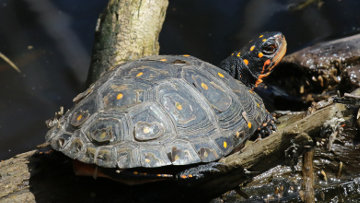Village News

PHOTO COURTESY OF GARRY KESSLER
Spotted turtle (Clemmys guttata).
June 26, 2020, Page A7
NATURE NOTES
By Annie Reid
Westborough Community Land Trust
June is the month for turtles
Why did the turtle cross the road? As every kid knows: to get to the other side. (Some might say, “to get to the shell station.”) But seriously, June is turtle month. Turtles are on the move, searching on land for warm, sandy spots to dig nests and lay eggs. You might find them crossing roads, trails, driveways, or even railroad tracks. Heed those roadside “Turtle Crossing” signs, and don’t run over anything that looks like a rock on the road.
What turtles are you most likely to see? Our common ones are painted turtles and snapping turtles, but very occasionally someone spots a spotted turtle (Clemmys guttata), as happened recently in Westborough. That’s a special treat, because until 2006 these small native turtles were a state-protected “species of special concern” in Massachusetts. Now they’re still rare.
Scott Shumway, biology professor at Wheaton College, explains:
“Studies in Westborough’s Cedar Swamp in the 1980s revealed that spotted turtles were surprisingly common there. This study and others led to this species being ‘de-listed’ or removed from the state endangered species list. This was great news – a rare species was not as rare as we had thought. However, it also means that some of the protections that helped keep it from becoming more rare, are no longer in place.”
Spotted turtles are small, only 3-5 inches long as adults. They’re dark with yellow or sometimes orange spots on their shell, neck, head, legs, and tail. The spots help to camouflage the turtle in the water, perhaps especially in a pond with duckweed dotting its surface. Each turtle has a different spot pattern, so you can recognize individual turtles and tell them apart. These turtles can live 26-50 years. Based on experiments with mazes, researchers estimate that spotted turtles are about as intelligent as mice.
What is a year in the life of a spotted turtle like? They overwinter in a dormant state in the mud in a pond or wetland, but emerge in March, even when there’s still ice in the water. Basking in the sun, feeding, and mating are their priorities. In early spring you might notice one sunning itself on a log or rock in a pond, swamp, or vernal pool, although at your approach it might flip itself into the water and dive for the muddy bottom.
In spring, spotted turtles often seek out vernal pools – those landlocked woodland pools that are full of water in the spring but dry up and disappear by late summer in most years. Spotted turtles are omnivores, so there they feed on algae, salamander and wood frog eggs, and the many insects and small creatures that breed or grow to adulthood there.
In April-May, spotted turtles mate in the water. We think of turtles as slow, but that’s on land, not in the water, when males chase a female. Males have brown eyes, a tan or brown chin, and a long tail. Females have orange eyes, a yellow or orange chin, and a shorter tail.
In late May and June, spotted turtles move onto land, to spend time hunting in wet meadows. Females look for places to lay their eggs. In a sunny, sandy spot, a female uses her hind legs to dig a nest, about 2 inches deep and 2 inches wide. After laying 3-4 eggs with flexible shells, she fills in the hole and moves her lower shell over the spot to smooth it. Then the eggs, and eventually the young, are on their own.
Warmth from the sun is key for developing turtles. Not only does warmth speed their development, but – amazingly to us – the temperature in the nest determines the sex of the baby turtles. During the middle third of their development, a nest temperature of 72-80 (F) degrees produces mostly male turtles. A nest temperature over 86 (F) degrees yields only females.
If the nest isn’t raided by a raccoon or a fox, the eggs hatch in August to September. Baby spotted turtles are round and about an inch wide. You’re unlikely to see them as they head for water. Sometimes they remain in the nest until the next spring.
Adults avoid the dryness and extreme heat of summer by burrowing into leaf litter or mud and becoming dormant. In September-October, most become active again and return to water. In October to November they go dormant again in a pond or wetland.
Would you like to see a spotted turtle? When the Visitor’s Center at Mass Audubon’s Broad Meadow Brook in Worcester opens, you can visit a spotted turtle in an aquarium there. Affectionately known as “Clem,” he’s more than 20 years old and often seems quite interested in his observers.